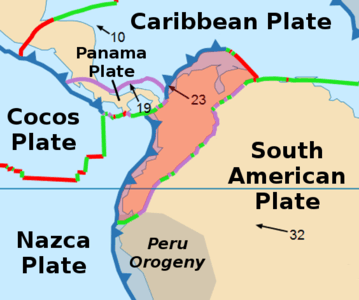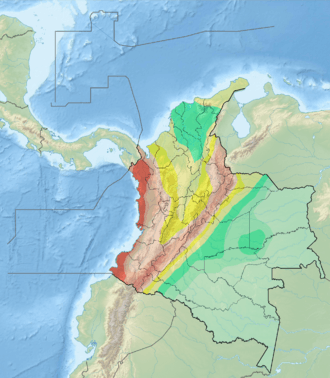1983 Popayán earthquake
The 1983 Popayán earthquake (Spanish: El Terremoto de Popayán) occurred on 31 March in Popayán, Colombia. It had a magnitude of at least 5.5[2] with an epicenter south west of Popayán at a depth of 12–15 kilometers (7.5–9.3 mi).[2] The earthquake killed 267 people and resulted in the passing of new laws requiring earthquake resistant building materials in zones at risk of tremors.
 | |
| UTC time | 1983-03-31 13:12:53 |
|---|---|
| ISC event | 581906 |
| USGS-ANSS | ComCat |
| Local date | 31 March 1983 |
| Local time | 08:13 (UTC-5) |
| Duration | 18–28 seconds |
| Magnitude | 5.5 Mw |
| Depth | 12–15 kilometers (7.5–9.3 mi) |
| Epicenter | 2.461°N 76.686°W[1] |
| Areas affected | Popayán, Colombia |
| Casualties | 267 killed |
Background
Popayán had been founded in 1537 and was renowned for its beauty and surviving examples of architecture from the Spanish colonial period.[3] The city had already suffered natural disasters and had been destroyed on three occasions by an earthquake and two volcanic eruptions.[3]
Earthquake
The 1983 earthquake occurred at 08:13 on Maundy Thursday of that year.[4] Although it lasted less than half a minute, damage to property was extensive[2] and 267 people were killed, with a further 7,500 people injured.[4] In total, 14,000 buildings were damaged, the majority of them in the city's historic centre.[4] 6,885 of them suffered damage greater than 50% to the structure and a further 4,500 minor damage. 2,470 houses collapsed.[2] Approximately $50 million of damage was caused.[5] Serious damage was also caused to local infrastructure. The residents were left without electricity and water, communications were affected and the damage to the town's airport meant that it could only be used by helicopters and smaller planes.[6] Many of the injured had to be airlifted to Cali, the nearest large city.[6]
The quake also affected many of the neighbouring towns and regions and in Cajibio, at least ten people were killed.[7]
Aftermath
The President of Colombia, Belisario Betancur, accompanied by other members of the government, visited the scene and attended the funerals which followed the disaster.[8] The government responded by securing credit from the World Bank and earmarked $80 million for the city, with half of this to be used for reconstruction and the rest for economic regeneration.[4]
Colombia also received assistance from other countries. The Spanish Red Cross sent material to help those injured, the Spanish government also offered assistance, while Venezuela sent a plane to provide medical assistance to the survivors and the United States sent material and medical supplies worth US$700,000.[9]
Many one and two-storey buildings which were damaged had been constructed using materials which could not resist earthquakes, based on a mistaken belief that these buildings would be unaffected by any earth tremors.[10] Consequently, the following year, the Colombian government passed a new building code (Spanish: Código Colombiano de Construcciones Sismorresistentes)[11] into legislation which required the construction of dwellings capable of resisting earthquakes.[2] The Colombian Seismic Network was also created, tasked with monitoring seismic changes.[12]
References
- "Significant Earthquake". Retrieved 6 December 2014.
- Cruz Hoyos, Santiago (31 March 1983). "Popayán conmemora los 30 años del terremoto que devastó la ciudad en 18 segundos". El País (Cali) (in Spanish). Colombia. Retrieved 5 December 2014.
- "Popayán, joya de la arquitectura colonial española". ABC (in Spanish). Madrid, Spain. 3 April 1983. Retrieved 6 December 2014.
- Mahecha Castro, Jahel (28 March 2013). "El día que la tierra rugió en Popayán". El Espectador (in Spanish). Colombia. Retrieved 5 December 2014.
- Hashizume, Michio; Lomnitz, Cinna (1985). "The Popayán, Colombia, earthquake of 31 March 1983". Bulletin of the Seismological Society of America. 75 (5): 1315–1326. Retrieved 5 December 2014.
- "La centenaria ciudad de Popayán arrasada por un fuerte terremoto". La Vanguardia (in Spanish). Barcelona, Spain. 1 April 1983. Retrieved 6 December 2014.
- "Los muertos por el terremoto de Colombia podrían ser cuatrocientos". ABC (in Spanish). Madrid, Spain. 3 April 1983. Retrieved 6 December 2014.
- "Entierro de 100 víctimas del terremoto de Popayán". El País (in Spanish). Spain. 3 April 1983. Retrieved 5 December 2014.
- "Solidaridad internacional con los damnificados". ABC (in Spanish). Madrid, Spain. 3 April 1983. Retrieved 6 December 2014.
- Tanvir Wasti, Syed (2003). Seismic Assessment and Rehabilitation of Existing Buildings. Springer Science & Business Media. p. 273. ISBN 9781402016257.
- Hermelín, Michel (2007). Entorno natural de 17 ciudades de Colombia (in Spanish). Universidad Eafit. p. 124. ISBN 9789588281704.
- Practice of Earthquake Hazard Assessment. DIANE Publishing. p. 70. ISBN 9780788115929.
External links
- The International Seismological Centre has a bibliography and/or authoritative data for this event.


